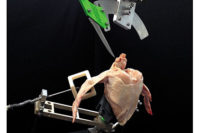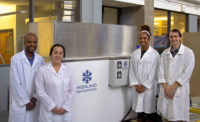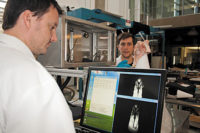To ensure water quality and safety under the Clean Water Act, the U.S. Environmental Protection Agency (EPA) regulates the amount of various types of nutrients that can be discharged from point sources into nearby lakes, streams or reservoirs. For the poultry industry, this means reducing the amount of phosphate (the inorganic form of phosphorus) in processing wastewater prior to discharge. When present in excessive amounts, phosphorus causes the growth of algae and other organisms that negatively affect the environmental and chemical balance of nearby water bodies.
In most poultry processing plants, aluminum, iron or calcium-based coagulants are used to remove phosphate from wastewater. This process known as chemical precipitation has its drawbacks due in large part to the costs associated with the use of metal salts and the resulting biosolids, which create an additional treatment problem. Could there be a more efficient and cost-effective way to remove phosphate? Researchers at the Georgia Tech Research Institute (GTRI) believe magnetic nanoparticles (MNPs) may hold promise.
These extremely small particles have a larger surface area relative to their volume, making them very effective adsorbents for just about any type of application where material removal is the goal.
“The advantageous capturing chemistry of magnetic nanoparticles and the ease at which they can be manipulated by external magnets enhance their adsorption capabilities,” says Dr. Jie Xu, GTRI senior research scientist and project director. “This makes their use particularly attractive for phosphate removal.”
Xu and fellow researchers have developed a proprietary phosphate removal chemistry, which is applied to the surface of an MNP to specifically attach phosphate molecules. The phosphate-attached MNPs can then be easily removed by an external magnet. The whole process can be conducted in a continuous flow-through device. This method can be used as the primary step for phosphate removal or as a refining step to remove excess phosphate from wastewater streams where a less efficient removal method has been used.
The prototype device contains a mixing chamber, magnetic separation chamber and an MNP regeneration chamber. The phosphate-containing wastewater and MNPs are introduced at the entrance of the device to go through the mixing and magnetic separation. MNPs are then separated from the liquid stream by an embedded permanent magnet and transported to a desired location for regeneration and reuse.
When tested in poultry processing wastewater, the prototype achieved more than 90 percent removal of phosphate in less than an hour. Testing results also showed the removal efficacy was not affected by the presence of organic compounds and common inorganic salts. The MNPs can be regenerated for repeated use, which lowers treatment costs. And the recovered phosphate can be used in fertilizer products, thus helping to extend nutrient sustainability.
“We achieved a pretty impressive removal efficiency,” says Xu. “We believe our prepared nanoparticle has great potential to be used as a phosphate adsorbent.”
The team continues to optimize the prototype and has filed an invention disclosure, “A continuous magnetic separation system for both wet and dry materials.”
“We are pleased with our progress so far and hope to ultimately provide the poultry industry with a low-cost alternative to current phosphate removal technology,” says Xu. NP
This article was originally published in PoultryTech. To view the publication, visit www.atrp.gatech.edu.





Report Abusive Comment